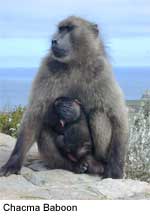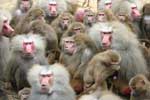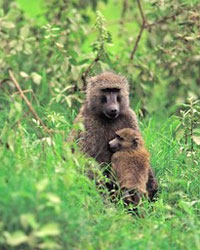|

All baboons have long dog-like muzzles, close-set eyes, heavy powerful jaws, thick fur except on their muzzle, a short tail and rough spots on their rear-ends, called ischial callosities. These callouses are nerveless, hairless pads of skin which provide for the sitting comfort of the baboon. Males of the Hamadryas baboon species also have a large white mane.
 Size: There is considerable variation in size and weight depending on species, the Chacma baboon can be 120 cm (47 inches) and weigh 40 kg (90 lb) while the biggest Guinea baboon is 50 cm (20 inches) and weighs only 14 kg (30 lb). Size: There is considerable variation in size and weight depending on species, the Chacma baboon can be 120 cm (47 inches) and weigh 40 kg (90 lb) while the biggest Guinea baboon is 50 cm (20 inches) and weighs only 14 kg (30 lb).
In all baboon species there is pronounced sexual dimorphism (the systematic difference in form between individuals of different sex in the same species), usually in size but also sometimes in color or canine development.
Habitat: Baboons are terrestrial (ground dwelling) and are found in savanna, open woodland and hills across Africa. Their diet is omnivorous, but is usually vegetarian. They are foragers and are active at irregular times throughout the day and night. They can raid human dwellings and in South Africa they have been known to prey on sheep and goats.
Man and leopard : Their principal predators are man and the leopard, although they are tough prey for a leopard and large males will often confront them.
Life expectancy: Baboons in captivity have been known to live up to 45 years, while in the wild their life expectancy is about 30 years.

 Social structure: Most baboons live in hierarchical troops of 5 to 250 animals (50 or so is common), depending on specific circumstances, especially species and time of year. The structure within the troop varies considerably between Hamadryas baboons and the remaining species, sometimes collectively referred to as savannah baboons. Social structure: Most baboons live in hierarchical troops of 5 to 250 animals (50 or so is common), depending on specific circumstances, especially species and time of year. The structure within the troop varies considerably between Hamadryas baboons and the remaining species, sometimes collectively referred to as savannah baboons.
Baboon harems: The Hamadryas baboon has very large groups comprised of many smaller harems (one male with four or so females), to which females from elsewhere in the troop are recruited while still too young to breed. The other baboon species have a more promiscuous structure with a strict dominance hierarchy based on the female matriline. The Hamadryas baboon group will typically include a younger male, but he will not attempt to mate with the females unless the older male is removed.
Dominance: Baboons can determine from vocal exchanges what the dominance relations between individuals are. When a confrontation occurs between different families or where a lower-ranking baboon takes the offensive, baboons show more interest in the exchange than exchanges between members of the same family or when a higher-ranking baboon takes the offensive. This is because confrontations between different families or rank challenges can have a wider impact on the whole troop than an internal conflict in a family or a baboon reinforcing its dominance.

Baboon mating behavior varies greatly depending on the social structure. In the mixed groups of savannah baboons, each male can mate with any female. The allowed mating order among the males depends partially on the ranking, and fights between males are not unusual.
Friends first: There are however also subtler possibilities; some males try to win the "friendship" of some females. To garner this friendship, they may help groom the female, help care for her young, or supply them with food. Some females actually prefer such "friendly" males as mates.
Rump presenting: A female initiates mating by presenting her swollen rump to the male. But 'presenting' can also be used as a submissive gesture and is observed in males as well.
Jealous husbands: In the harems of Hamadryas baboons, the males jealously guard their females, to the point of grabbing and biting the females when they wander too far away. Despite this, some males will raid harems for females. In such situations it often comes to aggressive fights by the males. Some males succeed in taking a female from another's harem. This is called a 'takeover'.
 Baby baboons: Females typically give birth every other year, usually to a single infant, after a six month gestation. The young baboon weighs approximately one kilogram and is colored black. The females tend to be the primary caretaker of the young, although several females will share the duties for all of their offspring. Baby baboons: Females typically give birth every other year, usually to a single infant, after a six month gestation. The young baboon weighs approximately one kilogram and is colored black. The females tend to be the primary caretaker of the young, although several females will share the duties for all of their offspring.
Male helpers: In mixed groups males sometimes help in caring for the young of the females they are "friendly" with, for instance they gather food for them and play with them. The probability is high that those young are their offspring. After about one year, the young animals are weaned. They reach sexual maturity in five to eight years.
In baboons males leave their birth group, usually before they reach sexual maturity, whereas females are 'philopatric' and stay in the same group their whole life.

There are five recognized species of Papio, although there is some disagreement about whether they are really full species or subspecies.
Sacred or Hamadryas Baboon, Papio hamadryas
Guinea Baboon, Papio papio
Olive Baboon, Papio anubis
Yellow Baboon, Papio cynocephalus
Chacma Baboon, Papio ursinus
The traditional 5-form classification probably under-represents the variation within Papio. Some commentators would argue that at least two more forms should be recognized, including the very small Kinda Baboon (P. kindae) from Zambia, the DRC, and Angola, and the Gray-footed Baboon (P. griseipes) found in Zambia, Botswana, Zimbabwe, Mozambique,and northern South Africa. However, current knowledge of the morphological, genetic, and behavioral diversity within Papio is too poor to make any final, comprehensive judgments on baboon taxonomy.
Howler Monkey | Lion Tamarin | Mandrill | Marmoset |Patas Monkey| Squirrel Monkey
Primates| Apes| Monkeys| Prosimians
All text is available under the terms
of the GNU Free Documentation License
|